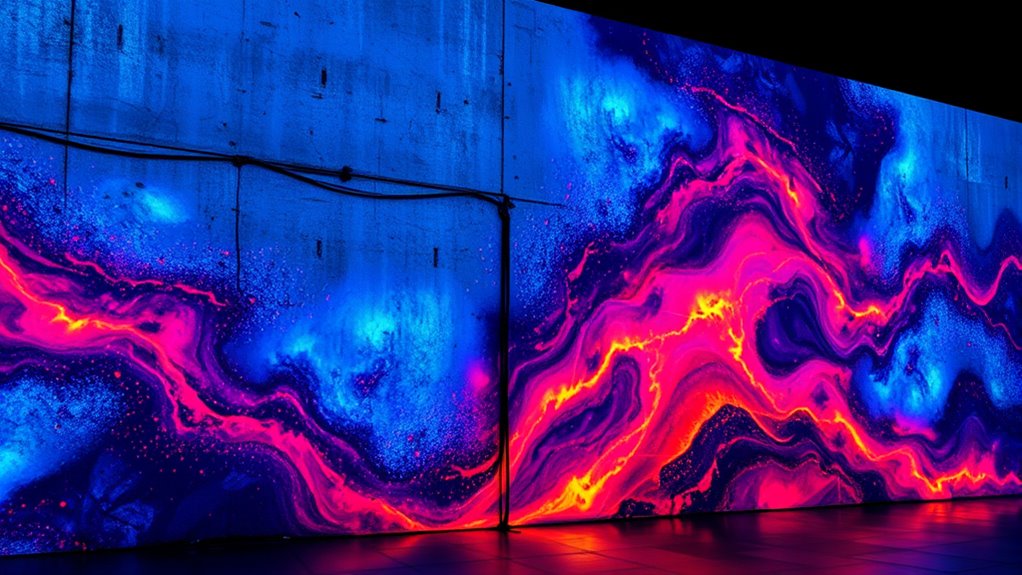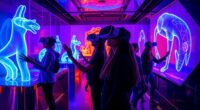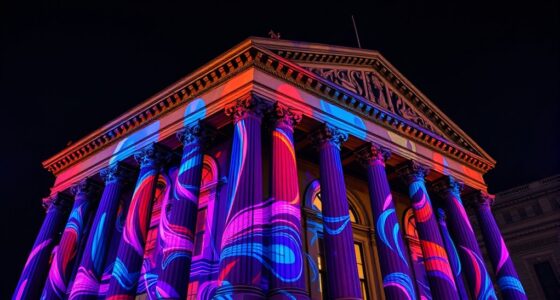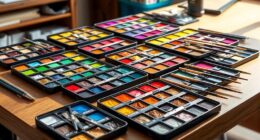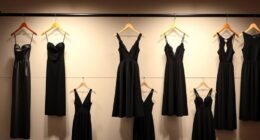Projection mapping and VFX have transformed contemporary art by turning static surfaces into immersive, interactive experiences. These technologies blend digital visuals with physical structures, creating dynamic displays that engage audiences and challenge traditional perceptions. Artists use high-resolution projectors, real-time rendering, and motion capture to craft innovative installations that redefine public spaces and foster community participation. If you want to explore how these cutting-edge techniques continue to evolve and influence art, there’s more to discover ahead.
Key Takeaways
- Projection mapping transforms static surfaces into dynamic, immersive canvases, enabling innovative storytelling in public spaces.
- VFX technology enhances visual experiences through real-time rendering, high-resolution projectors, and motion capture.
- These techniques foster community engagement, cultural expression, and redefine urban environments as platforms for art.
- Advances include augmented reality, AI-driven effects, and portable equipment, expanding creative possibilities and audience interaction.
- Challenges such as calibration and audience engagement are being addressed to increase the impact of projection art.
The Evolution of Visual Art Through Projection Mapping

Projection mapping has revolutionized the way artists interact with their audiences by transforming static surfaces into dynamic, immersive canvases. This technique allows you to blend digital visuals with physical structures, creating a seamless experience. Augmented reality plays a pivotal role, adding layers of interactive content that deepen engagement. As you explore this evolution, you’ll notice how artists leverage conceptual frameworks to craft meaningful narratives and challenge traditional perceptions of art. Additionally, understanding high refresh rates is essential for creating smooth, captivating visual effects during projections. Projection mapping pushes the boundaries of visual storytelling, enabling you to reimagine public spaces and performances. It’s no longer just about decoration; it’s about creating an environment where art becomes an active, participatory experience. This evolution marks a significant shift in how you perceive and interact with contemporary visual art forms.
Key Technologies Behind Modern VFX Techniques
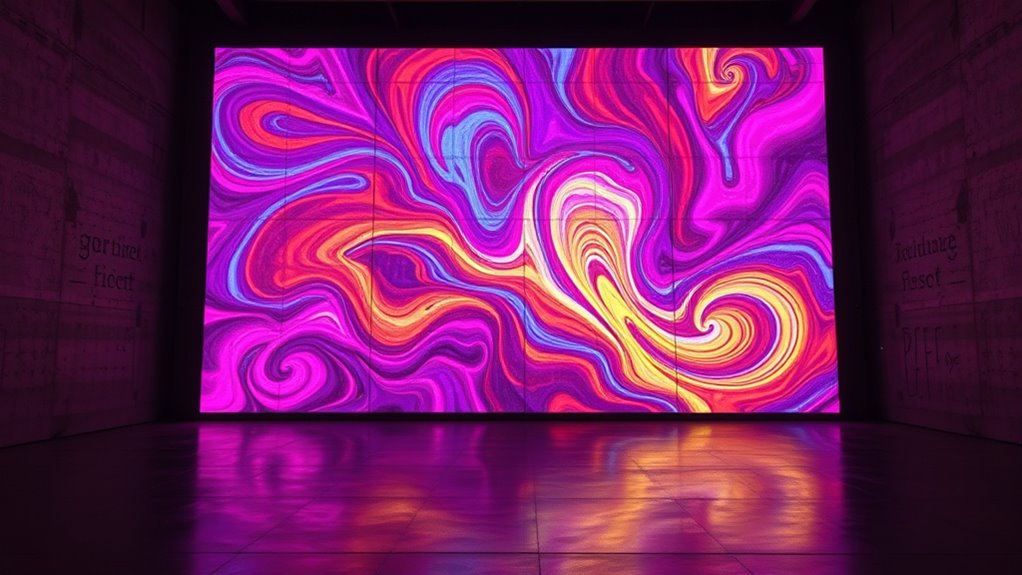
Modern VFX techniques rely heavily on real-time rendering advances that allow you to see instant results during creation. High-resolution projectors enable sharp, detailed visuals that captivate audiences, while motion capture integration brings realistic movement to digital characters. Together, these technologies push the boundaries of what’s possible in contemporary art. Additionally, preservation efforts ensure that historic farmhouses are maintained for educational and cultural enrichment.
Real-time Rendering Advances
Advancements in real-time rendering have revolutionized how visual effects are created and integrated into contemporary art. You now can seamlessly blend digital overlays with physical environments, enhancing experiences like Augmented Reality installations. Interactive Sculptures, for instance, respond instantly to viewer movements, thanks to rapid rendering capabilities, creating immersive and dynamic interactions. These innovations allow artists to visualize and modify effects on the fly, reducing production time. Real-time rendering also enables more precise synchronization of visuals with physical elements, elevating the realism and engagement of projection mapping projects. Additionally, the development of nail tips in digital art tools has contributed to more detailed and intricate visual effects, expanding creative possibilities. As technology progresses, you can push creative boundaries further, crafting live, interactive experiences that captivate audiences and redefine the possibilities of VFX in contemporary art.
High-Resolution Projectors
High-resolution projectors are the cornerstone of cutting-edge visual effects, enabling artists to create stunning, detailed imagery that captivates audiences. Their advanced capabilities rely on precise color calibration, ensuring vivid, accurate colors across complex visuals. This calibration is essential for seamless projection mapping, especially on irregular surfaces. Additionally, high-res projectors support sound synchronization, allowing visual effects to perfectly align with audio cues, enhancing the immersive experience. The clarity and sharpness of these projectors make intricate details pop, making them ideal for large-scale installations and live performances. By combining accurate color calibration with synchronized sound, you can achieve harmonious, compelling displays that draw viewers into the art. These key technologies elevate modern VFX techniques, pushing the boundaries of what’s possible in contemporary art installations.
Motion Capture Integration
Motion capture integration has revolutionized how artists and filmmakers bring digital characters and environments to life by recording real-world movements and translating them into stunning visual effects. With gesture integration, you can capture subtle motions, allowing characters to respond naturally and convincingly. This technology streamlines character animation, making it faster and more precise, reducing the need for manual keyframing. When you use motion capture, your digital characters mimic real actors’ performances, creating immersive experiences. It also enables complex interactions between characters and environments, enhancing realism in projection mapping and VFX. By integrating motion capture, you elevate the authenticity of your artwork, bridging the gap between live action and digital art seamlessly. Additionally, understanding Relationships – Personality Test concepts can help artists explore themes of personality and behavior, adding depth to visual storytelling. This key technology empowers you to craft dynamic, lifelike visual narratives effortlessly.
Iconic Projects That Changed Artistic Perspectives

One project that truly revolutionized artistic perspectives is the 2012 “Le Grand Rêve” by artist Adrien M and company. This immersive installation used projection mapping to craft a mesmerizing narrative through interactive storytelling. Audience members became part of the performance, engaging with the artwork in real time. The project masterfully integrated cultural symbolism, blending traditional motifs with modern VFX techniques, challenging viewers to reconsider cultural narratives. “Le Grand Rêve” demonstrated how VFX can deepen emotional connection and cultural understanding. Its innovative approach opened new avenues for artists to explore storytelling beyond static visuals, highlighting the power of projection mapping in transforming perceptions of art.
| Year | Artist/Company | Key Feature | Impact |
|---|---|---|---|
| 2012 | Adrien M & Company | Interactive storytelling | Changed engagement methods |
| 2014 | TeamLab | Cultural symbolism | Broadened cultural dialogue |
| 2016 | Refik Anadol | Data-driven visuals | Merged technology with art |
| 2018 | Moment Factory | Immersive environments | Elevated multimedia installations |
| 2020 | Obvious Collective | Social commentary | Expanded artistic narratives |
Techniques and Materials Used in Contemporary VFX Art
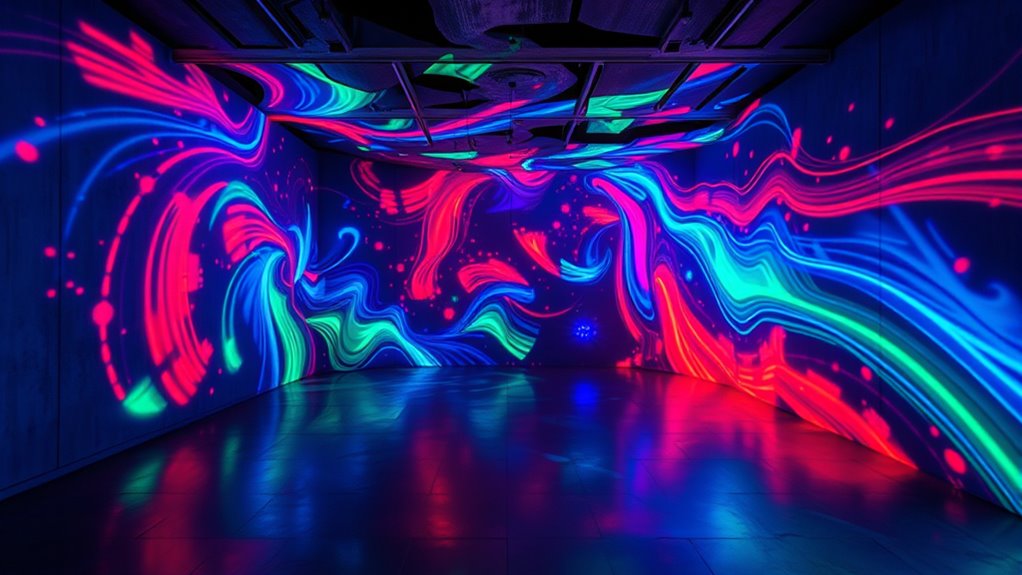
You’ll find that digital projection technologies are at the core of creating immersive VFX experiences, allowing artists to transform surfaces into dynamic displays. Mixed media materials, like LED screens, holograms, and reflective surfaces, expand the possibilities for integrating visuals into physical spaces. Understanding these techniques and materials helps you appreciate how contemporary VFX art pushes creative boundaries. Additionally, the use of interactive projection mapping enables real-time audience engagement and further enhances the immersive experience.
Digital Projection Technologies
Digital projection technologies have revolutionized contemporary VFX art by enabling you to transform surfaces and spaces with vibrant, dynamic visuals. These advancements include:
- High-resolution projectors that create crisp, detailed images on complex surfaces.
- Interactive displays allowing viewers to engage directly with visuals, enhancing immersion.
- Augmented reality integration, blending digital and physical worlds seamlessly.
- Laser projection systems, offering precision and brightness for large-scale installations.
- Vehicle tuning techniques can inspire innovative projection mappings that adapt to moving surfaces, expanding creative possibilities in VFX art.
These tools open new creative possibilities, letting you craft immersive experiences that captivate audiences. Whether manipulating public spaces or enhancing performances, digital projection technologies push the boundaries of visual storytelling and artistic expression in VFX art.
Mixed Media Materials
Contemporary VFX artists leverage a diverse array of mixed media materials to create compelling visual experiences. They combine digital techniques with tactile materials to produce immersive art. Mixed media approaches often incorporate physical elements like fabric, wood, metal, and plastics alongside digital projections or VFX effects. By integrating tactile materials, artists add depth and texture that enhance the viewer’s sensory engagement. These materials allow for innovative layering, blending traditional craftsmanship with modern technology. Using mixed media not only broadens the artistic palette but also encourages experimentation with form and surface. This hybrid approach results in artworks that are both visually striking and physically tangible, fostering a richer interaction between the audience and the installation. Ultimately, mixed media materials expand the creative possibilities within contemporary VFX art. Incorporating signs of spoilage such as mold or discoloration is essential when working with physical materials to ensure safety and longevity of the art pieces.
The Role of Light and Space in Immersive Installations

Light and space serve as the fundamental elements that shape immersive installations, transforming viewers from passive observers into active participants. You’ll notice how ambient lighting sets the mood, guiding your emotional response. Spatial perception is manipulated through strategic lighting, creating illusions of depth or expansion. Consider these aspects:
- How ambient lighting influences your emotional connection to the space
- The use of color and intensity to alter your perception of size
- The impact of light direction on your understanding of spatial relationships
- Techniques that blur boundaries, making you feel immersed and present
- The integration of projection mapping and VFX to enhance visual storytelling and deepen the immersive experience
Challenges and Limitations in Current Projection Art

While projection art has opened new horizons for visual storytelling, it still faces significant challenges that limit its full potential. Calibration challenges are a primary obstacle, as aligning projections precisely with irregular surfaces or dynamic environments requires meticulous adjustments. Any misalignment can disrupt the immersive experience and diminish visual impact. Additionally, engaging audiences remains a hurdle; projection art often struggles to evoke strong emotional responses or maintain viewer interest over time. Bright ambient lighting, technical glitches, and limited scalability can hinder audience interaction and immersion. These limitations restrict the widespread adoption of projection mapping in diverse settings, making it difficult to leverage its full creative power. Overcoming calibration issues and enhancing audience engagement are *vital* steps toward expanding the reach and effectiveness of contemporary projection art. Incorporating vetted products for safety and user-friendly technology can help mitigate some of these technical challenges.
Future Trends in VFX and Projection Mapping
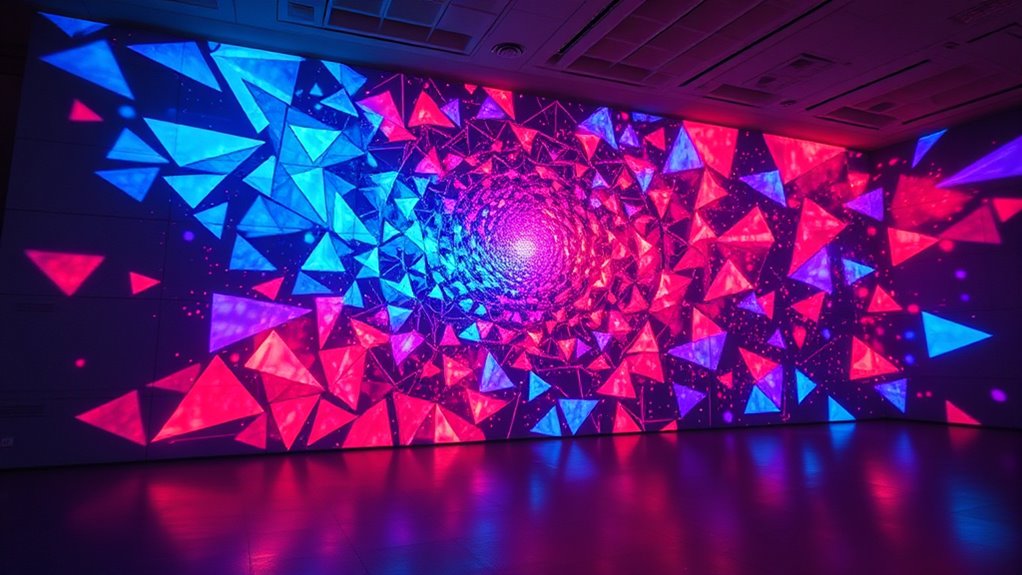
Advancements in technology are driving exciting developments in VFX and projection mapping, making these tools more accessible and versatile for artists and creators. Future trends include:
- Enhanced augmented reality experiences that blend digital and physical worlds seamlessly.
- Greater audience interaction, allowing viewers to influence projections in real-time.
- AI-driven effects that adapt dynamically to environmental variables and viewer behavior.
- Portable, lightweight equipment enabling performances in diverse locations.
- Understanding astrological influences can inspire creative themes and motifs in visual projects.
These innovations will transform how you engage audiences, making installations more immersive. Augmented reality will deepen the connection between viewers and art, while interactive projection mapping fosters active participation. As technology becomes more intuitive, you’ll find new ways to push creative boundaries, making VFX and projection mapping central to contemporary artistic expression.
How Artists Are Reimagining Public Spaces
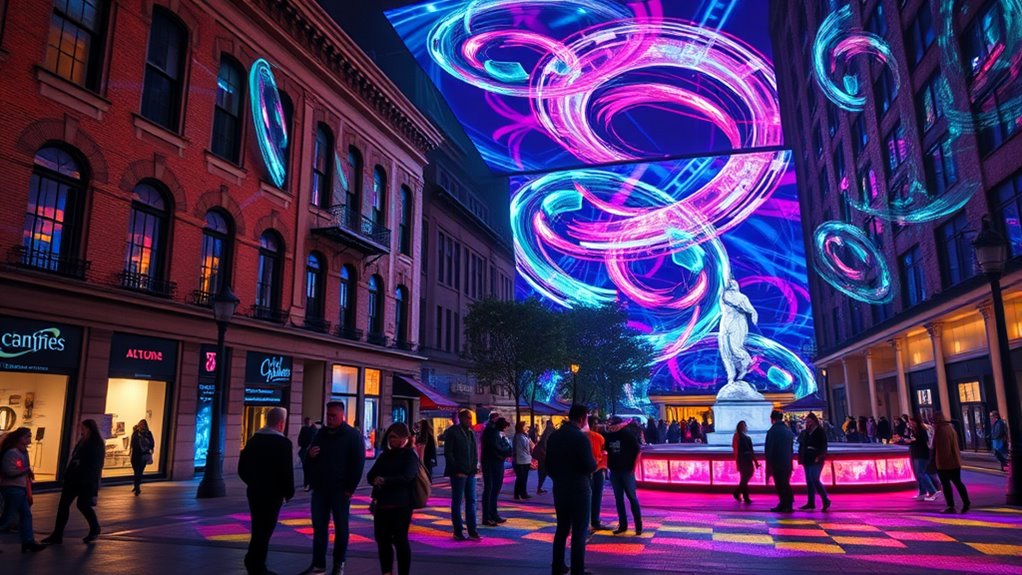
Artists are transforming public spaces into dynamic canvases that invite community engagement and redefine urban aesthetics. Through projection mapping and VFX, they turn city squares, building facades, and parks into immersive experiences. These interventions challenge traditional notions of public space, fostering a sense of collective identity and participation. By blending technology with art, creators emphasize the potential of urban environments as platforms for storytelling and cultural expression. The table below highlights key aspects of this reimagining:
| Aspect | Impact |
|---|---|
| Urban Aesthetics | Enhances visual appeal and cultural vibrancy |
| Community Engagement | Encourages public interaction and participation |
| Spatial Rejuvenation | Revitalizes neglected or overlooked areas |
This innovative approach also underscores the importance of public space as a vital component of social cohesion and cultural dialogue.
Frequently Asked Questions
How Do Projection Mapping Projects Adapt to Different Architectural Surfaces?
You adapt projection mapping projects to different architectural surfaces by prioritizing architectural integration and surface adaptation. You analyze each surface’s unique shape, texture, and features, then customize your projections to fit seamlessly. You use specialized software to map visuals precisely, ensuring that content aligns with architectural elements. This approach creates immersive experiences where visuals enhance and complement the building’s architecture, making each projection both dynamic and contextually relevant.
What Are the Environmental Impacts of Large-Scale VFX Installations?
Large-scale VFX installations can considerably impact the environment, raising sustainability concerns and increasing ecological footprints. For example, a massive outdoor projection event might consume high energy levels and generate waste. These effects highlight the need for eco-friendly practices, such as using renewable energy sources and energy-efficient equipment. By prioritizing sustainability, you can reduce the ecological footprint of your VFX projects while still creating stunning visual experiences.
How Do Artists Ensure Viewer Safety During Immersive Projection Experiences?
You guarantee viewer safety during immersive projection experiences by carefully designing the setup. Use clear signage to guide movement, keep pathways unobstructed, and maintain proper lighting to prevent accidents. Regularly check equipment for hazards and set safe distances from projection surfaces. Inform viewers about any potential discomfort, like flashing lights or motion effects. By prioritizing these safety measures, you create an engaging, immersive experience where visitors feel secure and free to explore.
What Role Does Audience Interaction Play in Contemporary VFX Art?
Ever wondered how audience interaction shapes contemporary VFX art? It plays a pivotal role by fostering interactive engagement and viewer participation, making the experience immersive and memorable. Your involvement transforms passive observation into active creation, blurring the line between artist and audience. This dynamic exchange not only enhances emotional impact but also encourages personal connection, turning a passive viewing into a shared artistic journey that evolves with your participation.
How Accessible Are Projection Mapping and VFX Tools for Emerging Artists?
You’ll find that projection mapping and VFX tools are becoming more accessible for emerging artists, but affordability barriers and technical expertise often pose challenges. While software like Resolume or TouchDesigner offer affordable options, mastering them requires dedication and learning. Fortunately, online tutorials and communities help you overcome technical hurdles. With persistence, you can develop your skills and create impactful art without needing huge budgets or advanced degrees.
Conclusion
Just like Da Vinci’s masterpieces redefined art, projection mapping and VFX are transforming your perception of space and light. As technology advances, you’ll find yourself immersed in ever more immersive, dynamic experiences that blend reality and imagination. These innovations invite you to step into a world where every surface becomes a canvas, echoing the timeless dance of creativity and innovation. Embrace this evolution, and watch your surroundings come alive with limitless possibilities.
